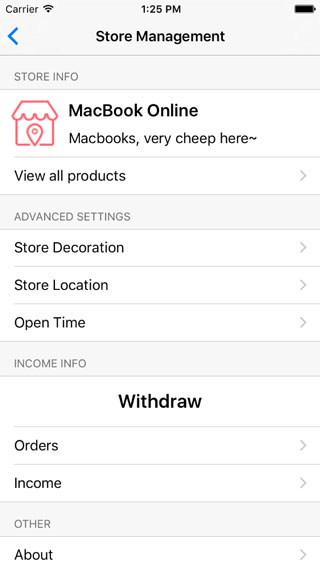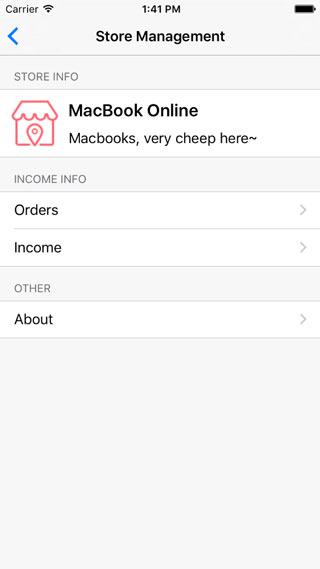实战:通过ViewModel规范TableView界面开发

TableView界面可以说是移动App中最常用的界面之一了,物品/消息列表、详情编辑、属性设置……几乎每个app都可以看到它的身影。如何优美地实现一个TableView界面,就成了iOS开发者的必备技能。
一般地,实现一个UITableView, 需要通过它的两套protocols,UITableViewDataSource和UITableViewDelegate,来指定页面内容并响应用户操作。常用的方法有:
@protocol UITableViewDataSource- (NSInteger)numberOfSectionsInTableView:(UITableView *)tableView; - (NSInteger)tableView:(UITableView *)tableView numberOfRowsInSection:(NSInteger)section; - (UITableViewCell *)tableView:(UITableView *)tableView cellForRowAtIndexPath:(NSIndexPath *)indexPath - (nullable NSString *)tableView:(UITableView *)tableView titleForHeaderInSection:(NSInteger)section; - (nullable NSString *)tableView:(UITableView *)tableView titleForFooterInSection:(NSInteger)section; ... @end @protocol UITableViewDelegate- (CGFloat)tableView:(UITableView *)tableView heightForRowAtIndexPath:(NSIndexPath *)indexPath; - (CGFloat)tableView:(UITableView *)tableView heightForHeaderInSection:(NSInteger)section; - (CGFloat)tableView:(UITableView *)tableView heightForFooterInSection:(NSInteger)section; - (void)tableView:(UITableView *)tableView didSelectRowAtIndexPath:(NSIndexPath *)indexPath; ... @end
可见,完整地实现一个UITableView,需要在较多的方法中设定UI逻辑。TabeView结构简单时还好,但当它相对复杂时,比如存在多种TableViewCell,实现时很容易出现界面逻辑混乱,代码冗余重复的情况。
让我们看一个例子,实现一个店铺管理的界面 :

界面包括4个sections(STORE INFO, ADVANCED SETTINGS, INCOME INFO, OTHER)和3种cells(带icon的店铺名称cell,各项设置的入口cell和较高Withdraw cell)。此外,会有2种不同的用户使用这个界面:经理和普通职员。经理可以看到上述所有信息,普通职员只能看到其中一部分,如下:

按照传统方式,直接实现UITableViewDataSource和UITableViewDelegate, 代码可能会是这样的:
#pragma mark - UITableViewDataSource - (NSInteger)numberOfSectionsInTableView:(UITableView *)tableView { switch (self.type) { case MemberTypeEmployee: return 3; break; case MemberTypeManager: return 4; break; default: return 3; break; } } - (NSInteger)tableView:(UITableView *)tableView numberOfRowsInSection:(NSInteger)section { if (section == 0) { if (self.type == MemberTypeEmployee) { return 1; // only store info } else { return 2; // store info and goods entry } } else if (section == 1) { if (self.type == MemberTypeEmployee) { return 2; // order list } else { return 3; // advanced settings... } } else if (section == 2) { if (self.type == MemberTypeEmployee) { return 1; // about } else { return 3; // store income and withdraw } } else { return 1; // about } } ... 在另外的几个protocol方法中,还有更多的这种if else判断,特别是tableView:cellForRowAtIndexPath:方法。具体代码可以参看 Github项目 中的BadTableViewController中的实现。
这样的实现当然是非常不规范的。可以想象,如果界面需求发生变化,调整行数或将某个cell的位置移动一下,修改成本是非常大的。问题的原因也很明显,代码中存在如此之多的hard code值和重复的逻辑,分散在了各个protocol方法中。所以解决这个问题,我们需要通过一种方法将所有这些UI逻辑集中起来。
如果你知道MVVM模式的话,你肯定会想到通过一个ViewModel来持有所有的界面数据及逻辑。比如通过一个Array持有所有section信息, 其中每个section对象持有需要用到的sectionTitle及其cellArray。同样,cellArray中的每个cell对象持有cell的高度,显示等信息。ViewModel的接口定义如下:
@interface TableViewModel:NSObject @property (nonatomic, strong) NSMutableArray *sectionModelArray; @end @interface TableViewSectionModel : NSObject @property (nonatomic, strong) NSMutableArray *cellModelArray; @property (nonatomic, strong) NSString *headerTitle; @property (nonatomic, strong) NSString *footerTitle; @end typedef NS_ENUM(NSInteger, CellType) { CellTypeIconText, CellTypeBigText, CellTypeDesc }; @interface TableViewCellModel : NSObject @property (nonatomic, assign) CGFloat height; @property (nonatomic, assign) CGFloat cellType; @property (nonatomic, retain) UIImage *icon; @property (nonatomic, retain) NSString *mainTitle; @property (nonatomic, retain) NSString *subTitle; @end 这时,UITableView的那些protocol方法可以这样实现:
@implementation TableViewModel - (NSInteger)numberOfSectionsInTableView:(UITableView *)tableView { return self.sectionModelArray.count; } - (NSInteger)tableView:(UITableView *)tableView numberOfRowsInSection:(NSInteger)section { YZSTableViewSectionModel *sectionModel = self.sectionModelArray[section]; return sectionModel.cellModelArray.count; } - (UITableViewCell *)tableView:(UITableView *)tableView cellForRowAtIndexPath:(NSIndexPath *)indexPath { YZSTableViewCellModel *cellModel = [self cellModelAtIndexPath:indexPath]; UITableViewCell *cell = nil; switch (cell.cellType) { case CellTypeIconText: { ... break; } case CellTypeBigText: { ... break; } case CellTypeDesc: { ... break; } } return cell; } ... @end 在TableViewController中,我们只需要构造TableViewModel的sectionModelArray就可以了。这样的实现无疑进步了很多,所有UI逻辑集中到了一处,基本消除了hard code值及重复代码。代码可读性大大增强,维护和扩展难度大大降低。
但同时我们也发现了一个问题,这个TableViewModel是不可重用的。它的属性设置决定了它只能用于例子中的店铺管理界面。如果我们需要另外实现一个详情编辑页面,就需要创建另一个TableViewModel. 这就导致使用上的不易和推广难度的增加。特别是在团队中,我们需要对每个成员进行规范方式的培训和代码实现的review,才能保证没有不规范的实现方式,成本较高。
如何让TableViewMode通用起来呢?我们发现上述例子中,造成不通用的原因主要是TableViewCellModel的定义。一些业务逻辑耦合进了cell model,如cellType,icon, mainTitle, subTitle。 并不是所有的界面都有这些元素的。所以我们需要通过一种通用的描述方式来取代上述属性。
上述属性主要是用来实现UITableViewCell的,有什么办法可以不指定这些内容,同时让TableViewModel知道如何实现一个cell呢?我们可以用block!
通过block,我们可以把UITableViewCell的实现逻辑封装起来. 在需要时,执行这个block就可以得到对应的cell对象。
同理,cell的点击响应,willDisplay等事件,都可以通过block的方式进行封装。于是一个通用的TableViewModel可以这样定义:
@interface YZSTableViewModel : NSObject @property (nonatomic, strong) NSMutableArray *sectionModelArray; @end typedef UIView * (^YZSViewRenderBlock)(NSInteger section, UITableView *tableView); @interface YZSTableViewSectionModel : NSObject @property (nonatomic, strong) NSMutableArray *cellModelArray; @property (nonatomic, strong) NSString *headerTitle; @property (nonatomic, strong) NSString *footerTitle; ... @end typedef UITableViewCell * (^YZSCellRenderBlock)(NSIndexPath *indexPath, UITableView *tableView); typedef void (^YZSCellSelectionBlock)(NSIndexPath *indexPath, UITableView *tableView); ... @interface YZSTableViewCellModel : NSObject @property (nonatomic, copy) YZSCellRenderBlock renderBlock; @property (nonatomic, copy) YZSCellSelectionBlock selectionBlock; @property (nonatomic, assign) CGFloat height; ... @end
(篇幅原因,仅列出了部分接口,更多内容可以参看: https://github.com/youzan/SigmaTableViewModel )
UITableView的那些protocol方法也有了通用的实现方式:
@implementation YZSTableViewModel ... #pragma mark - UITableViewDataSource - (NSInteger)tableView:(UITableView *)tableView numberOfRowsInSection:(NSInteger)section { YZSTableViewSectionModel *sectionModel = [self sectionModelAtSection:section]; return sectionModel.cellModelArray.count; } - (UITableViewCell *)tableView:(UITableView *)tableView cellForRowAtIndexPath:(NSIndexPath *)indexPath { YZSTableViewCellModel *cellModel = [self cellModelAtIndexPath:indexPath]; UITableViewCell *cell = nil; YZSCellRenderBlock renderBlock = cellModel.renderBlock; if (renderBlock) { cell = renderBlock(indexPath, tableView); } return cell; } ... #pragma mark - UITableViewDelegate ... - (void)tableView:(UITableView *)tableView didSelectRowAtIndexPath:(NSIndexPath *)indexPath { YZSTableViewCellModel *cellModel = [self cellModelAtIndexPath:indexPath]; YZSCellSelectionBlock selectionBlock = cellModel.selectionBlock; if (selectionBlock) { selectionBlock(indexPath, tableView); } } ... @end 让我们回到文章开始的例子,实现这个相对复杂的店铺管理页面。通过SigmaTableViewModel,我们只需要:
- (void)viewDidLoad { [super viewDidLoad]; self.viewModel = [[YZSTableViewModel alloc] init]; self.tableView.delegate = self.viewModel; self.tableView.dataSource = self.viewModel; [self initViewModel]; [self.tableView reloadData]; } - (void)initViewModel { [self.viewModel.sectionModelArray removeAllObjects]; [self.viewModel.sectionModelArray addObject:[self storeInfoSection]]; if (self.type == MemberTypeManager) { [self.viewModel.sectionModelArray addObject:[self advancedSettinsSection]]; } [self.viewModel.sectionModelArray addObject:[self incomeInfoSection]]; [self.viewModel.sectionModelArray addObject:[self otherSection]]; } - (YZSTableViewSectionModel*)storeInfoSection { YZSTableViewSectionModel *sectionModel = [[YZSTableViewSectionModel alloc] init]; ... // store info cell YZSTableViewCellModel *cellModel = [[YZSTableViewCellModel alloc] init]; [sectionModel.cellModelArray addObject:cellModel]; cellModel.height = 80; cellModel.renderBlock = ^UITableViewCell *(NSIndexPath *indexPath, UITableView *tableView) { ... }; if (self.type == MemberTypeManager) { // product list cell YZSTableViewCellModel *cellModel = [[YZSTableViewCellModel alloc] init]; [sectionModel.cellModelArray addObject:cellModel]; cellModel.renderBlock = ^UITableViewCell *(NSIndexPath *indexPath, UITableView *tableView) { ... }; cellModel.selectionBlock = ^(NSIndexPath *indexPath, UITableView *tableView) { [tableView deselectRowAtIndexPath:indexPath animated:YES]; ... }; } return sectionModel; } ... 所有的TableView界面实现,都统一成了初始化 SigmaTableViewModel 的过程。
注:SigmaTableViewModel仅提供了一些常用的TableiVew protocol方法的实现。如果需要其未实现的方法,可以创建它的子类,在子类中提供对应方法的实现。同时因为block的大量使用,需要注意通过weak-strong dance避免循环引用。如果担心block中持有过多代码造成内存的增加,可以将代码实现在另外的方法中,在block中调用这些方法即可。











![[HBLOG]公众号](https://www.liuhaihua.cn/img/qrcode_gzh.jpg)

